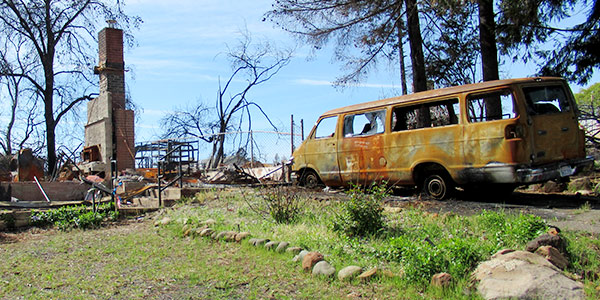By Hudson Sangree
The federal judge in charge of PG&E Corp.’s bankruptcy rejected the utility’s argument that it isn’t subject to California’s legal doctrine of inverse condemnation, which holds investor-owned utilities strictly liable for damage to private property caused by their electrical equipment, regardless of fault.
PG&E and other IOUs have argued for years, in courts and in the State Capitol, that they shouldn’t be held responsible for wildfires sparked by their equipment absent a showing of negligence.
The most recent effort was waged before U.S. Bankruptcy Judge Dennis Montali in San Francisco. (See PG&E Seeks to Escape Inverse Condemnation.)
PG&E and its main utility subsidiary, Pacific Gas and Electric, the debtors in the Chapter 11 bankruptcy case, challenged the application of inverse condemnation to them in connection with wildfires in 2015, 2017 and 2018.
They asked Montali to rule that the state’s strict no-fault liability scheme does not apply to private utilities after a 2017 decision by the California Public Utilities Commission involving San Diego Gas & Electric. PG&E contended the CPUC ruling had undermined the ability of IOUs to pass on the costs of wildfires to ratepayers, which PG&E called a core tenet of inverse condemnation.
“Debtors do not appear to contest seriously the legal landscape of inverse condemnation, which is soundly against them,” Montali wrote in his ruling Wednesday. “Instead, they argue that the SDG&E decision renders prior decisions incorrect and that the policy considerations of inverse condemnation demand a result in their favor.”
PG&E told Montali he could limit the application of inverse condemnation to IOUs if he found the state Supreme Court was likely to reach a similar conclusion. The state’s highest court has never ruled on the issue, though lower appellate courts have unanimously held that IOUs are subject to inverse condemnation.
Lawyers representing fire victims and insurance companies said the arguments had no merit and were countered by more than a century of case law.
In his decision, Montali said much of PG&E’s argument boiled down to the idea that a privately owned utility shouldn’t be treated the same as a public utility under the doctrine of inverse condemnation, which has been embedded in California’s constitution since the mid-1800s and consistently applied by the courts to regulated utilities and railroads.
State lawmakers have refused repeated efforts to alter the law, including a push by PG&E in July to amend the doctrine to favor IOUs, the judge said.
“This court is not tasked to determine what the law should be and is merely tasked with interpreting what the law is and has been for 125 years,” Montali wrote. “The California legislature has not taken up [PG&E’s] cause to their satisfaction, and this court will not attempt to take its place.”
‘Prudent Manager’
Montali also said he thought it unlikely the state Supreme Court would find in PG&E’s favor, and he rejected the argument by PG&E that the 2017 CPUC decision had jeopardized its ability to spread wildfire costs to ratepayers.
In that decision, the CPUC rejected an application by SDG&E to recover its costs from paying out damages for two major wildfires in 2007. The commission found SDG&E had failed to “reasonably manage and operate its facilities” prior to the fires, saying only the prudence principle, and not inverse condemnation, was relevant to its ruling. PG&E argued the CPUC’s decision meant wildfire costs from inverse condemnation could no longer be spread to ratepayers.
Montali, however, said the CPUC had simply applied its longstanding reasonableness test to SDG&E. That test allows a utility to recover wildfire costs through higher rates only if it acted as a “prudent manager” in operating its grid.
“Essentially, the CPUC evaluates a private utility’s behavior to ensure that it has comported with best practices before it is able to pass on costs to the ratepayers,” the judge wrote.
Inverse condemnation is based on the concept that an entity, public or private, is responsible for damage it causes to private property because it has the power to seize private property for the public good, Montali said. The socialization of those damages is not a central component of inverse condemnation as described in the state constitution and decisions interpreting it, he said.
Since the 1870s, the state constitution has provided that “private property may be taken or damaged for a public use … only when just compensation” is paid to the owner. The provision was initially intended to stem the power of the Southern Pacific Railroad. For decades, courts have interpreted the provision to mean that regulated, monopolistic utilities must compensate property owners whose houses and businesses are destroyed by wildfires sparked by electrical equipment.
PG&E filed for bankruptcy in January following two years of devastating wildfires. State fire investigators found the utility’s equipment ignited 21 major fires in Northern California’s wine country in October 2017 and started the Camp Fire in November 2018. The Camp Fire killed 86 people and destroyed more than 14,000 homes and hundreds of businesses in the Sierra Nevada foothills town of Paradise.
“Debtors have admitted that their equipment was the cause of all the wildfires except the Tubbs Fire; they have not admitted liability for any of them,” Montali noted.
A trial in state court to determine if PG&E started the Tubbs Fire, which killed 22 people and leveled a neighborhood in the city of Santa Rosa, begins in January. Proceedings to estimate PG&E’s monetary liability in the other fires is occurring before another federal judge in San Francisco, subject to the rules of inverse condemnation.



